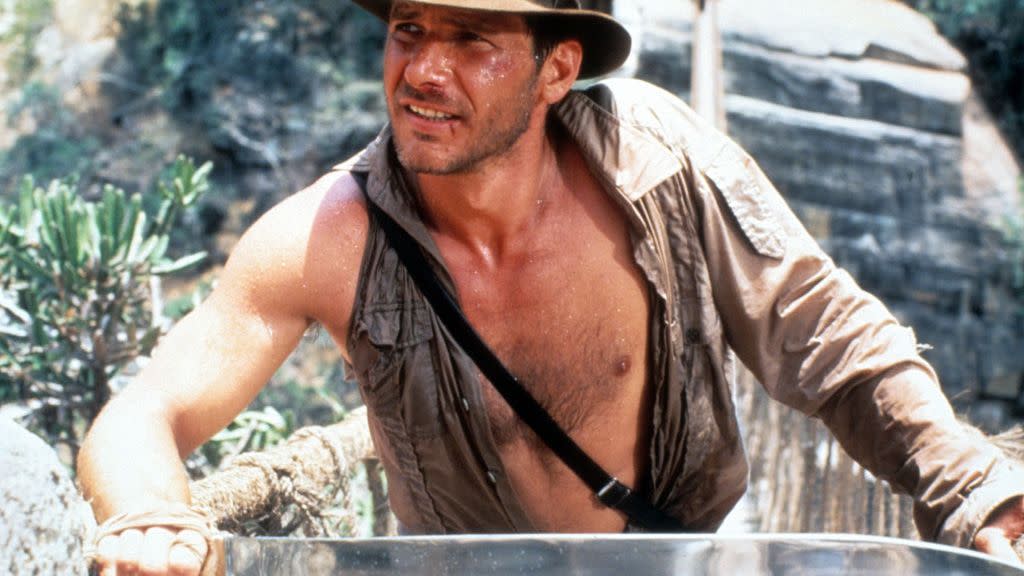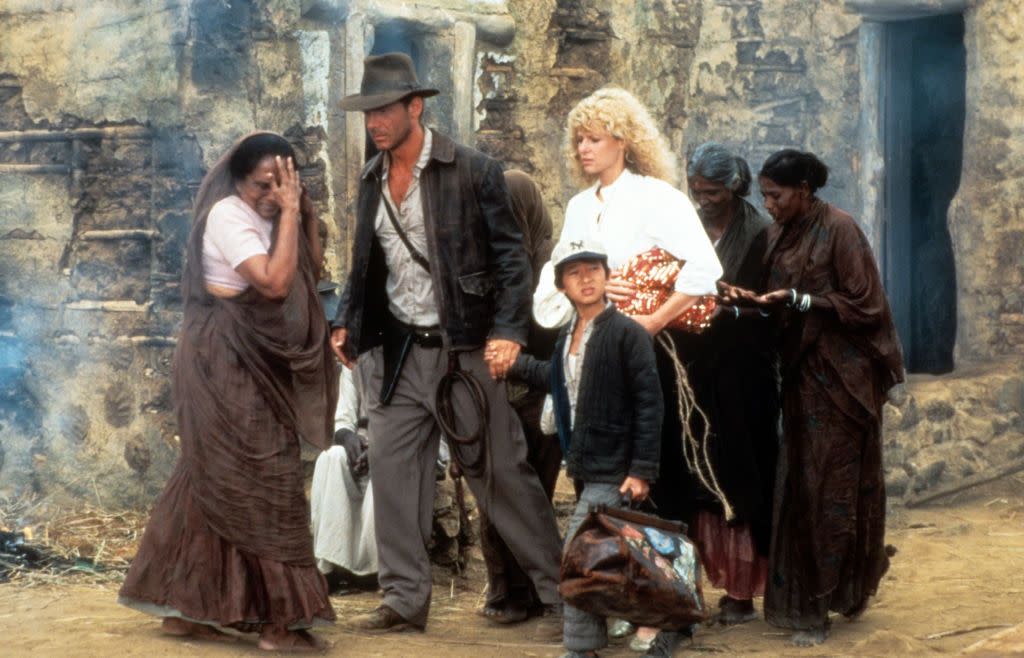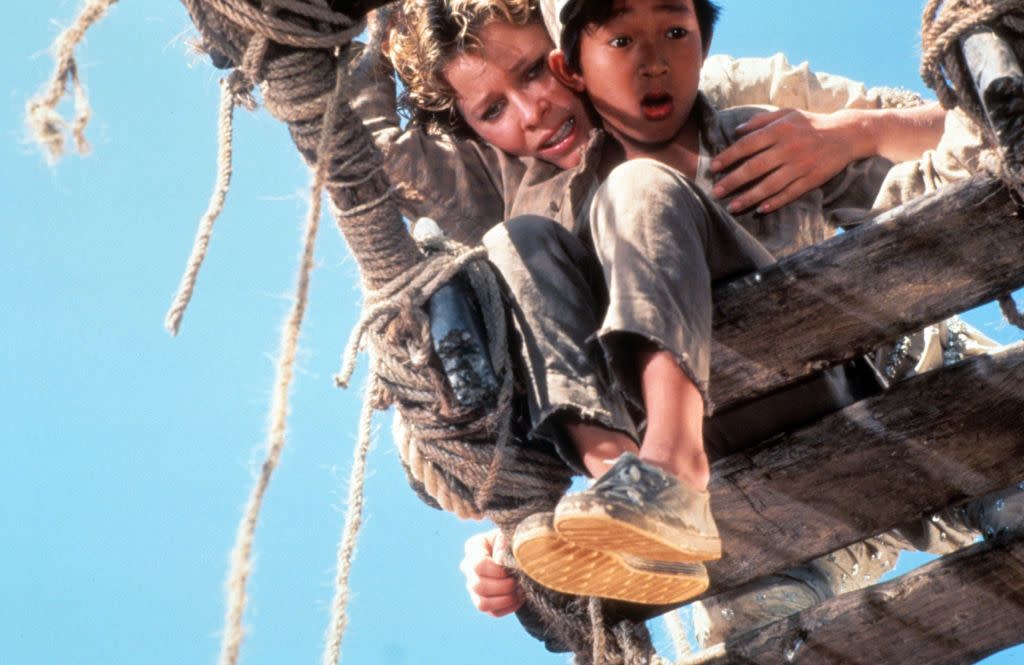Steven Spielberg Once Disowned ‘The Temple of Doom.’ It’s Better Than He Thinks.

"Hearst Magazines and Yahoo may earn commission or revenue on some items through these links."
On this day, forty years ago, Steven Spielberg released a wildly entertaining action-adventure that received almost universally positive reviews and made more than $330 million at the box office. That film was 1984’s Indiana Jones and the Temple of Doom, a sequel (well, technically a prequel, since it’s set in 1935) that deftly manages to be both scarier and sillier than its predecessor. So why did its director feel the need to disown it?
By almost any metric, Spielberg’s follow-up to Raiders of the Lost Ark is a movie that any other director would kill to have on their résumé. Its masterful Busby Berkeley–style song-and-dance opening sequence set in a Shanghai nightclub showcases some of the most inventive and kinetic filmmaking of the decade. But in 1989, just five short years after the movie hit multiplexes, Spielberg would offer a confusing mea culpa for the film, slagging it as “too dark” and “too horrific” before harshly concluding: “There’s not an ounce of my personal feeling in Temple of Doom.”
That opinion is certainly Spielberg’s prerogative. But I don’t buy it for a second. First of all, it’s impossible to watch a scene like Temple of Doom’s mine-cart chase and not see the work of a director who’s having an absolute fucking blast. There’s plenty of personal feeling in it. Perhaps it just wasn’t the kind of personal feeling he wanted to be known for at the time. I suspect the real reason Spielberg felt the need to Monday-morning-quarterback the film is that until that point in his career, he was the careful custodian of a certain image he was trying to protect. And with Temple of Doom, he gave us a peek behind the curtain at a more cartoonishly sadistic side of himself he didn’t want the public to see. Not yet, at least.
Let me explain. By the early 1980s, it was impossible to be a more successful—and celebrated—filmmaker than Señor Spielbergo. He had made Jaws and Close Encounters of the Third Kind. And if you ignore the 1983 anthology film Twilight Zone: The Movie (and you should), Temple of Doom was Spielberg’s first film in the wake of E.T. the Extra-Terrestrial, the beloved box-office phenomenon that turned him into Hollywood’s most famous Peter Pan–like man-child. He was Hollywood’s reigning pixie-dust confectioner, the wonder-and-awe heir to Walt Disney. And Temple of Doom’s plot about kidnapped children being forced to slave away in an underground prison mine didn’t square with that image.
Yes, Temple of Doom is an undeniably darker film than Raiders. But that’s hardly a knock. It’s a bonus. While Spielberg was busy washing his hands of the movie, executive producer George Lucas was a little more candid about the reason behind that darkness, admitting that he and Spielberg were in a weird place at the time. “Part of it was I was going through a divorce, Steven had just broken up [with his girlfriend], and we were not in a good mood, so we decided on something a little more edgy. It ended up darker than we thought it would be. Once we got out of our bad moods, which went on for a year or two, we kind of looked at it and went, Mmmm, we certainly took it to the extreme.”

Hindsight’s a bitch. But let’s be clear about the words dark, edgy, and extreme. We’re talking about Temple of Doom—a movie that has our heroes plummeting out of an airplane in an inflatable yellow raft and landing safely in the Himalayas before white-water-rafting though a Country Bear Jamboree version of India. It’s not exactly Taxi Driver or Requiem for a Dream.
Beyond controlling the narrative of his money-minting, kid-friendly rep at the time, Spielberg also apologized for the film in 1989, I suspect, because Temple of Doom represented something that he wasn’t quite comfortable with at the time: the idea of making sequels. After all, from the moment that Jaws entered the record books as the top-grossing movie in cinema history, Spielberg was barraged with pleas to direct a Great White sequel—something he had always dismissed as cynical and craven. Now, less than a decade later, here he was on the Temple of Doom set in Jaipur making one. How could he not feel like a bit of a sell-out?
None of this is to say that Temple of Doom doesn’t have its problems. It does. Especially when looking at it from the more enlightened vantage point we live in today. First off, and there’s no getting around this, it’s a little xenophobic and racist. India is painted as an exotic land where voodoo, human sacrifice, and superstition are not only alive and well, but hearts are ripped out of people’s chests in black-magic rites. The country’s villagers are poor and backwards and require Indiana Jones to be their white savior. Meanwhile, the banquet at Pankot Palace is presented as a barrage of cheap, gross-out gags, where locals’ eyes widen deliriously at the savory delights of giant beetles which are slurped like oysters, eyeball soup, and chilled monkey brains.

There’s also a slightly bitter aftertaste left by the chauvinistic way that Kate Capshaw’s shrill, gold-digging nightclub singer is presented. She’s a damsel in distress constantly in the need of rescuing. She seems more concerned about wooing a wealthy, underaged maharajah and breaking a manicured fingernail than saving children corralled into subterranean servitude. If Spielberg has anything to apologize for with Temple of Doom, it’s not the film’s darkness, but rather it’s lightest moments. Capshaw’s excruciating shrieking and slapstick. She’s the anti-Marion Ravenwood, and she seems to complain without pausing to take a breath for 118 minutes.
Still, four decades later, the things that work well in Temple of Doom, work really well. And they more than make up for the things that don’t. The Club Obi Wan set piece may be (along with Raiders’ opening chased-by-a-giant-boulder boobytrapfest) the most thrillingly exuberant sequence Spielberg has ever directed: A first-rate villain is introduced (Roy Chiao’s dagger-sideburned Lao Che); McGuffins are trotted out (the priceless remains of Nurhachi) only to be be quickly forgotten; Indy is slipped a Mickey; gems, gold, and poison antidotes are swapped via a lazy susan; machine-gun fire is ducked thanks to a giant, rolling gong; and cackling henchmen are impaled with flaming skewers.
Second only to that opening volley is Spielberg’s final half hour and its showstopping mine-cart chase—a wildy inventive, white-knuckle Rube Goldberg machine playing out on celluloid. Spielberg puts the greatest action hero of the ‘80s on the greatest rollercoaster of all time. And can we all just agree that 12-year-old Ke Huy Quan is the film’s stealth MVP as Short Round? The character and the actor are both pure joy. He also has, in my opinion, the most electric on-screen chemistry with Harrison Ford of any character in the five-film series. Which is saying something because Harrison Ford is not a guy who makes chemistry easy, electric or otherwise.
In his 1984 review of Temple of Doom, critic Roger Ebert gave the film four out of four stars, writing: “This movie is one of the most relentlessly nonstop action pictures ever made, with a virtuoso series of climactic sequences that must last an hour and never stop for a second. It’s a roller-coaster ride, a visual extravaganza, a technical triumph, and a whole lot of fun.”
Then, like an aisle-seat Nostradamus, Ebert seems to predict its director’s forthcoming disavowal. “Indiana Jones and the Temple of Doom makes no apologies for being exactly what it is: Exhilarating, manic, wildly imaginative escapism. No apologies are necessary. This is the most cheerfully exciting, bizarre, goofy, romantic adventure since Raiders, and it is high praise to say that it’s not so much a sequel as an equal.”
I couldn’t agree more.
You Might Also Like
